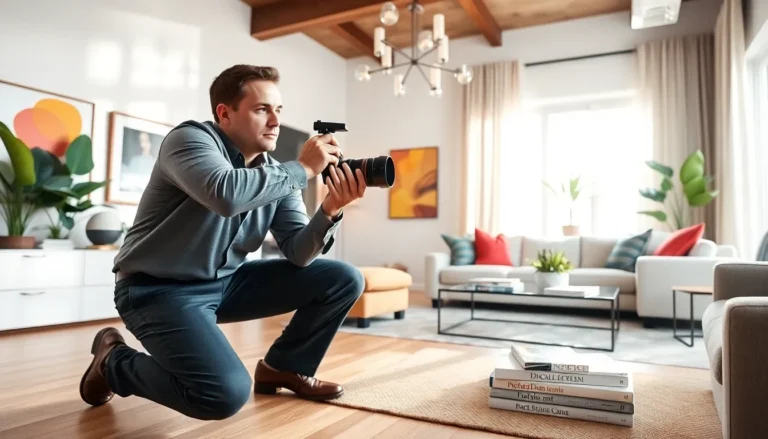When it comes to home design, few styles are as vibrant and full of life as Mexican house design. Imagine stepping into a world where colors pop like a piñata at a party and architectural details whisper tales of tradition. This style isn’t just about aesthetics; it’s a celebration of culture, history, and the joy of living.
From sun-soaked courtyards to intricate tile work that could make a Picasso blush, Mexican homes embrace a warm, inviting atmosphere. They blend indoor and outdoor spaces seamlessly, allowing nature to become part of the living experience. Whether you’re dreaming of building a new home or just looking to sprinkle some Mexican flair into your space, understanding the essence of this design can transform any house into a vibrant sanctuary that feels like a fiesta every day.
Table of Contents
ToggleOverview of Mexican House Design
Mexican house design reflects a rich cultural heritage, showcasing vibrant colors and handcrafted details. Intricate tile work, often featuring geometric patterns, adorns floors and walls, adding to each home’s unique character. Sun-soaked courtyards serve as central gathering spaces, creating an inviting atmosphere for family and friends.
Natural elements play a significant role in the design, with large windows maximizing natural light and connecting indoor areas with the surrounding environment. Terra cotta roofs and adobe walls provide both aesthetic appeal and functional benefits, offering insulation and durability.
Many homes incorporate lush gardens filled with native plants, enhancing the sensory experience and promoting biodiversity. Traditional features such as arches and wrought iron accents emphasize craftsmanship and historical significance. Vibrant textiles and art pieces often accentuate the interiors, celebrating local artisans and cultural narratives.
Sustainability remains a key aspect, with many designs prioritizing eco-friendly materials and energy efficiency. The essence of Mexican house design lies in its ability to foster community, inviting a lively, festive spirit into everyday life. Integrating these elements creates a sanctified living space that resonates with warmth and joy.
Key Characteristics of Mexican House Design

Mexican house design embodies a celebration of culture and community through various features.
Use of Natural Materials
Natural materials dominate Mexican architecture. Adobe, a sun-dried brick, serves as a primary building component. Terra cotta tiles enhance roofing, providing visual warmth and rustic charm. Wood beams and wrought iron accents add structural integrity and aesthetic appeal. These materials contribute to thermal efficiency, ensuring comfortable living conditions year-round. Many homes incorporate stone and clay, reflecting regional availability and craftsmanship. Sustainability remains a focal point, with these elements requiring minimal processing and supporting local industries. Each material tells a story, linking the home to its surroundings and heritage.
Vibrant Color Palettes
Vibrant color palettes characterize the interiors and exteriors of Mexican houses. Bold hues such as deep oranges, bright blues, and vivid yellows create an inviting atmosphere. Colorful tiles often adorn facades and floors, enhancing visual interest and showcasing traditional artistry. Each shade reflects cultural symbolism, infusing spaces with energy and emotion. Accent walls often highlight focal points, while decorative details such as painted pottery complement the overall design. The integration of textiles, featuring rich patterns and colors, further enriches the visual experience. This emphasis on color fosters a lively environment that resonates with the essence of Mexican living.
Cultural Influences in Mexican House Design
Mexican house design showcases a rich tapestry of cultural influences, rooted in history and tradition.
Indigenous Traditions
Indigenous traditions form the foundation of Mexican architecture. They emphasize the use of natural materials like adobe, stone, and wood. These elements promote durability and reflect the local environment. Indigenous designs often include open courtyards, which foster community interaction. Homes feature intricate motifs that echo pre-Hispanic craftsmanship, celebrating ancient cultures. Moreover, the focus on sustainability resonates with indigenous practices, ensuring harmony between humans and nature.
Spanish Colonial Impact
Spanish colonial influences heavily shape Mexican house design. This period introduced elements like arches, tile roofs, and wrought iron details. Influences often showcase grand entrances and expansive patios that enhance outdoor living. The use of vibrant tiles for decorative elements stems from the Spanish tradition. Architectural styles merged during this era, resulting in buildings that blend function and aesthetics. Spanish aesthetics and indigenous techniques create a distinctive character in Mexican homes today.
Modern Trends in Mexican House Design
Modern trends in Mexican house design embrace sustainability and enhance the connection between indoor and outdoor spaces. Designers prioritize eco-friendly materials, promoting energy efficiency across various designs.
Sustainable Practices
Sustainable practices form a central theme in contemporary Mexican homes. Many builders utilize eco-friendly materials such as reclaimed wood, bamboo, and low-impact paints. Focus shifts to passive cooling techniques, helping to reduce energy requirements. Integrating rainwater harvesting systems ensures water efficiency. Also, homeowners often select plants native to the region, creating landscapes that thrive with minimal water. By highlighting local craftsmanship, these designs contribute to the community and economy. Ultimately, these practices not only respect the environment but also celebrate the heritage of Mexican architecture.
Integration of Indoor and Outdoor Spaces
Integration of indoor and outdoor spaces marks another defining trend. Open floor plans create fluid transitions between living areas and courtyards. Large sliding doors maximize natural light and foster airflow, enhancing comfort. Courtyards often feature gardens, pools, or seating areas, encouraging outdoor living. Designers frequently use materials like clay tiles and natural stones, seamlessly blending aesthetics with functionality. Outdoor kitchens become popular, allowing for entertaining in a natural setting. This approach nurtures a connection with nature, promoting tranquility and well-being in daily life.
Mexican house design offers a unique blend of cultural richness and modern sustainability. Its vibrant colors and handcrafted details create inviting spaces that celebrate both heritage and community. By incorporating natural materials and eco-friendly practices, these homes not only reflect a deep connection to the environment but also foster a sense of tranquility and joy. Whether building anew or enhancing existing spaces, embracing this style can transform any home into a lively sanctuary that resonates with the spirit of Mexico.



